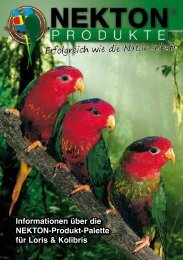Create successful ePaper yourself
Turn your PDF publications into a flip-book with our unique Google optimized e-Paper software.
of the stamen enables the hummer to pollinate<br />
the blossom by transporting the pollen,<br />
clearly showing the interdependence of bird<br />
and flower.<br />
A further peculiarity of humming birds is their<br />
ability to lower their body temperature in<br />
emergencies, slowing down the rate of metabolism<br />
and thus drastically saving energy.<br />
Last but by no means least, we must not forget<br />
to mention the brilliant, iridescent colours<br />
of most humming bird varieties - the feathers<br />
glittering or dulling as the light moves over<br />
them. No wonder these birds are sometimes<br />
called „Jewels in Flight“.<br />
Their glittering plumage, whirring flight and<br />
fascinating life and behaviour have made<br />
humming birds one of the most interesting<br />
members of the bird kingdom.<br />
Basic Rules for Keeping<br />
Humming Birds<br />
Years ago keeping humming birds caused<br />
considerable difficulties. In the early stages<br />
not enough was known about the living and<br />
feeding habits of these birds, so that<br />
false ideas of what<br />
was involved<br />
often preventedaviculturists<br />
from realising this dream. Today, however,<br />
any serious bird fancier can fulfil this wish<br />
if he is prepared to take a little care in the<br />
requirements of these attractive birds in captivity.<br />
The most frequent questions asked by prospective<br />
humming bird owners are where to<br />
keep them and how to feed them. The following<br />
answers and further tips plus expert<br />
advice should smooth the way to making<br />
ownership of these birds a real joy and constant<br />
source of pleasure.<br />
Unlike many other bird families, they do not<br />
live in groups so that keeping different species<br />
together in one aviary presents certain<br />
problems. In view of the aggressiveness<br />
typical of almost all humming bird species,<br />
placing each single bird in a cage of its own<br />
is not a „make-do“ solution but a true necessity.<br />
A so-called crate cage L80 x B50 x H60<br />
cm with two thin twigs, either with a smooth<br />
bark or bark removed, a bird bath (e.g. coaster<br />
for a plant pot, approx. 20 cm diam.)<br />
half-way up the side of the cage make an<br />
ideal home. Place the feeder tube at a height<br />
where the bird can reach it easily from a sitting<br />
position, too. The NEKTON feeders are<br />
especially designed for feeding nectar-taking<br />
birds and obtainable in any good pet store or<br />
department. Made of brown plexiglass, the<br />
feeder cuts off ultraviolet rays, meaning the<br />
important vitamins and the protein-rich food<br />
mixture keep longer. Cover the floor of the<br />
cage with absorbent, dust-free material such<br />
as newspapers or cat litter and change weekly.<br />
In order to keep different humming birds<br />
together in one aviary it is necessary to<br />
know something about the behaviour of<br />
the species. In any case, they should<br />
only be kept together in aviaries with<br />
thick foliage to provide them with<br />
hiding place. There should always<br />
be more feeders than birds. The<br />
same species or birds similar in<br />
appearance should not be put<br />
together.



